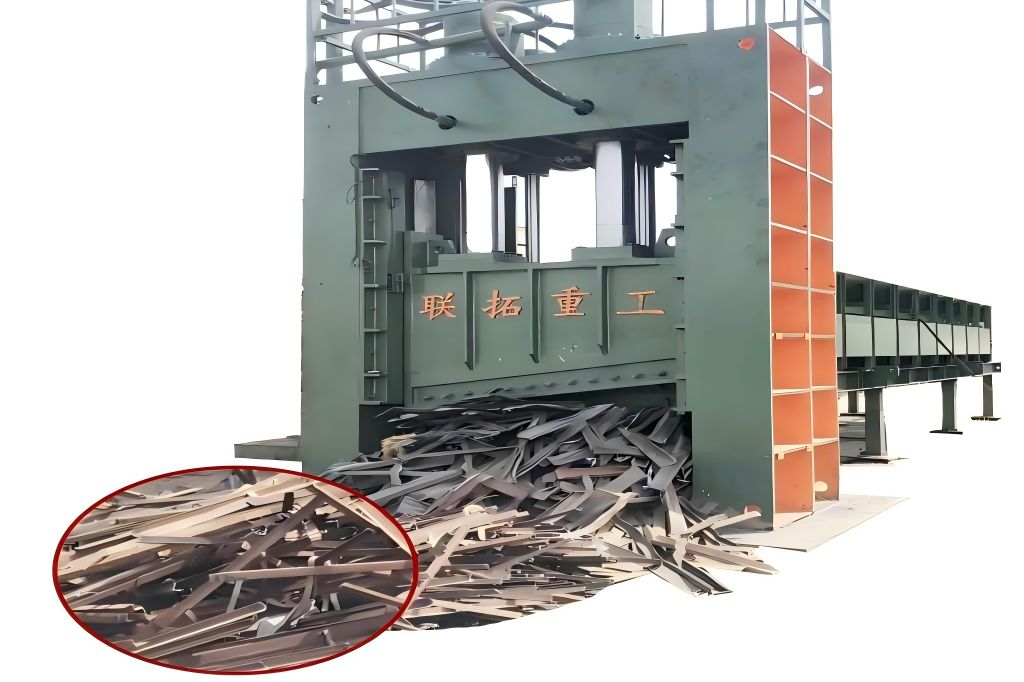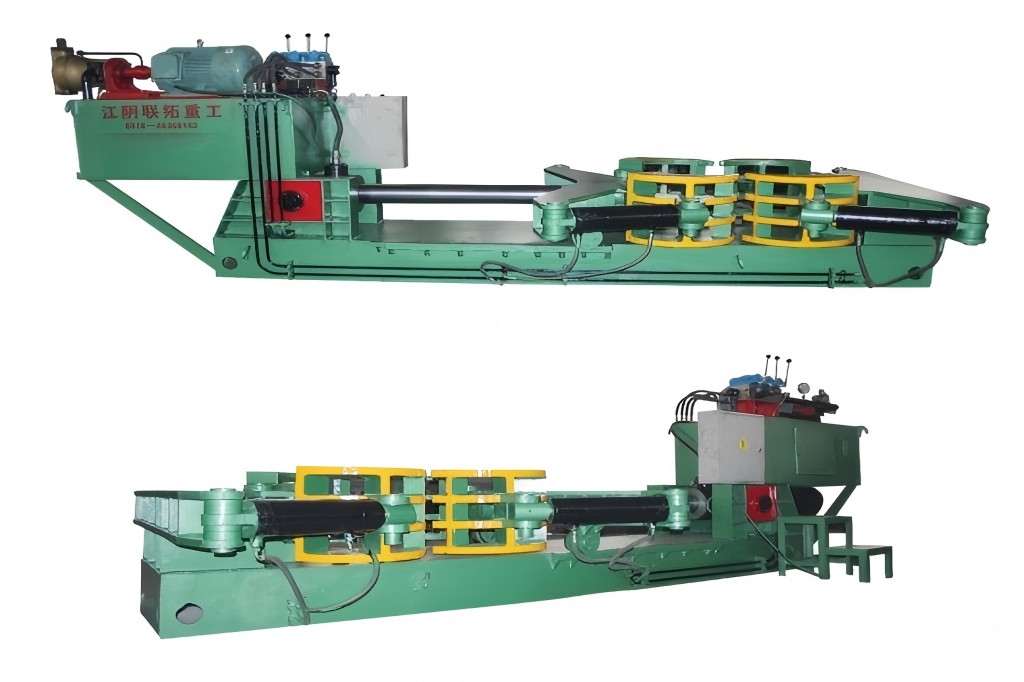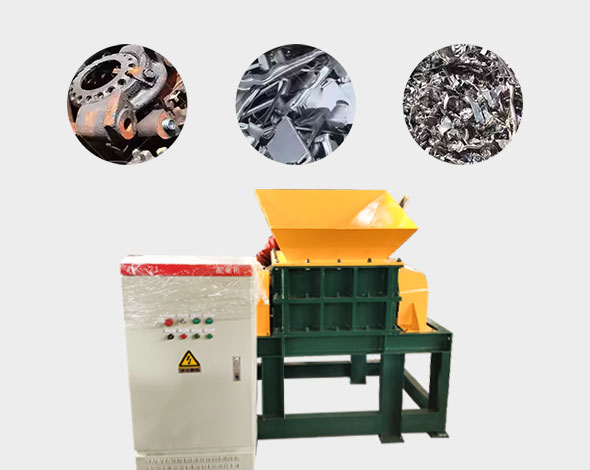Hydraulic gantry shears play a vital role in heavy industrial applications, offering precision and efficiency for cutting large metal pieces. These machines are used in industries like metal recycling, steel manufacturing, and shipbuilding, where their ability to handle massive materials and deliver high accuracy is critical.
This guide provides a comprehensive look into the functions, advantages, and applications of hydraulic gantry shears, helping businesses make informed decisions when choosing the right machine for their operations.
Understanding Hydraulic Gantry Shears
Hydraulic gantry shears are heavy-duty machines built for precise cutting of thick metal materials. Their robust construction and hydraulic systems enable smooth, powerful cutting for high-stress tasks. Below are their core components and principles.
Core Components
There are various vital parts that make up hydraulic gantry shears, and each one is important to the cutting operation:
- Machine Power: The machine is propelled forward by its hydraulic system. It includes a pump, control valves, hydraulic fluid, and cylinders, which together create the pressure needed to move the cutting blade with great force.
- Cutting Blade: The cutting blade is made from high-strength steel or tungsten carbide, designed to maintain sharpness and durability through repeated use. It slices through metal materials, and its sharpness and geometry are critical to the cutting performance.
- Gantry Structure: The gantry is the supporting frame that holds the cutting blade and material in place. It provides stability during cutting operations, ensuring that the material does not move and that the cut is precise.
- Control Panel: Gives operators the ability to adjust parameters such as material thickness, cutting force, and blade speed. Modern gantry shears often include digital control systems, such as CNC (Computer Numerical Control), which enable precise automated operations.
- Hydraulic Reservoir: The reservoir stores the hydraulic fluid, which powers the system. The fluid must be properly maintained and cooled to ensure efficient performance.
- Power Unit: The motor that powers the hydraulic pump makes up the power unit. Larger machines require powerful motors to generate the necessary hydraulic pressure.
These components work together to provide efficient, accurate, and powerful cutting performance, making hydraulic gantry shears indispensable in demanding industrial settings.
Principles of Hydraulic Power in Shearing
The operation of hydraulic gantry shears relies on hydraulic power, a system that uses pressurized fluid to generate mechanical force.Hydraulic power’s fundamental ideas are as follows:
- Pascal’s Law: Pressure applied to a confined fluid causes uniform transmission of pressure in all directions. In hydraulic systems, this allows for significant force to be generated from relatively small input pressures.
- Hydraulic fluid pressure: The fluid is forced by a hydraulic pump, which in turn propels the hydraulic cylinders. These cylinders transfer the fluid’s pressure into mechanical motion, which powers the cutting blade.
- Force Multiplication: Hydraulic systems multiply the input force, providing the machine with the strength needed to cut through thick and dense materials. This amplification allows hydraulic gantry shears to operate efficiently with minimal input energy.
- Precision Control: Hydraulic systems enable precise control over blade speed and pressure, allowing operators to make accurate cuts. Modern hydraulic systems often include servo controls, allowing for real-time adjustments based on material type and cutting requirements.
The combination of force multiplication and precision control makes hydraulic gantry shears ideal for handling large-scale cutting tasks that require both power and accuracy.
Advantages of Hydraulic Gantry Shears
The following advantages make hydraulic gantry shears a reliable and efficient choice for industries that demand precision and power in cutting operations.
High Cutting Precision: Hydraulic gantry shears provide precise cuts with tolerances as tight as ±0.2 mm, minimizing material waste and ensuring high-quality results.
- Ability to Handle Thick Materials: These machines can cut materials up to 200 mm thick, making them ideal for heavy-duty tasks in industries such as steel manufacturing and shipbuilding.
- Efficiency and Speed: With shearing frequencies of 3-5 cuts per minute and high production capacities (up to 25 tons per hour), hydraulic gantry shears enhance productivity in large-scale operations.
- Automation and CNC Integration: Many modern machines come equipped with CNC systems, allowing for automated, precise cutting and reduced need for manual intervention, lowering labor costs.
- Rugged Construction and Durability: Built from reinforced steel, hydraulic gantry shears are designed for long-term use, capable of withstanding extreme conditions and offering a service life of up to 25 years.
- Energy Efficiency: Modern hydraulic systems are optimized to reduce energy consumption while maintaining high cutting power, improving both cost-effectiveness and environmental impact.
- Versatility: These machines are used across various industries, including metal recycling, steel manufacturing, shipbuilding, and heavy equipment production, making them versatile for multiple applications.
Applications of Hydraulic Gantry Shears
Hydraulic gantry shears are versatile machines used across various industries for heavy-duty cutting tasks. Key applications include:
- Scrap Metal Recycling: Essential for processing and reducing large scrap metal pieces into smaller, manageable sizes for recycling, significantly enhancing efficiency and throughput.
- Automotive Industry: Used for cutting high-strength materials like steel and aluminum in the production of automotive parts, ensuring precision in vehicle component manufacturing.
- Construction and Demolition: Hydraulic gantry shears cut through thick steel beams and structural components, aiding in both construction and demolition projects by providing clean, precise cuts.
- Manufacturing: They play a key role in cutting large metal sheets and components for various manufacturing processes, ensuring materials are accurately sized for production.
- Shipbuilding and Repair: These machines are crucial for cutting large steel plates and beams used in the construction and repair of ships, meeting the industry’s stringent demands for accuracy and strength.
- Railway Industry: Hydraulic gantry shears are employed in the cutting and shaping of rails, components, and metal parts used in railway construction and maintenance.
How to Select the Appropriate Hydraulic Gantry Shear
Choosing the right hydraulic gantry shear is crucial for optimizing efficiency, minimizing costs, and ensuring durability. Key factors include material type, production volume, cutting capacity, and budget. Below are considerations for selecting the best machine.
Type of Material to Be Cut
The material you cut is a key factor in selecting a hydraulic gantry shear. Different materials like steel, aluminum, copper, or alloys require specific cutting capacities and blade types.
- Steel: Requires a high cutting force due to its density and thickness. Machines with a cutting force between 500-1,250 tons are generally recommended.
- Aluminum and Copper: Softer metals can be cut with lower cutting forces, typically between 250-500 tons.
- Specialty Alloys: May require more advanced blade materials, such as tungsten carbide, and higher precision for accurate cuts.
Required Cutting Thickness and Size
Your requirement for a machine will be directly impacted by the thickness and dimensions of the materials you operate with. Hydraulic gantry shears come with varying cutting capacities, ranging from 5 mm to 200 mm in thickness, and blade lengths from 1,200 mm to 2,000 mm. For example:
- Small to Medium-Scale Operations: Machines with a cutting force of 250-500 tons and blade lengths around 1,200 mm are ideal for cutting thin to moderately thick materials.
- Large-Scale Operations: Heavy-duty machines with 500-1,250 tons of cutting force and blade lengths of 1,800 mm or more are suitable for cutting very thick steel beams and plates.
Production Volume
Your production requirements will help determine the capacity and size of the hydraulic gantry shear you need. High-volume operations, such as those in steel manufacturing or shipbuilding, may require machines with high production capacities and faster shearing frequencies.
- Low to Medium Production: Machines with capacities between 2-6 tons per hour and shearing frequencies of 3-5 cuts per minute are ideal for moderate workloads.
- High Production: For large-scale operations that process 15-25 tons per hour, machines with higher cutting forces and larger chambers are recommended.
Automation and Precision Requirements
For industries like automotive or aerospace, where precise cuts are critical, choosing a hydraulic gantry shear with CNC (Computer Numerical Control) integration can greatly enhance production efficiency. Automated systems allow for:
- Improved Accuracy: Tolerances as tight as ±0.2 mm are achievable with CNC systems, reducing material waste and ensuring uniform cuts.
- Labor Saved: By reducing the need for manual intervention, automated systems increase throughput while saving labor expenditures.
Budget Considerations
The budget is usually a crucial consideration when selecting any industrial apparatus. The cost of hydraulic gantry shears varies depending on cutting force, automation, production capacity, and the material of construction.
While higher-capacity machines with advanced features come at a premium, investing in the right machine can offer long-term savings through increased productivity, lower maintenance costs, and reduced downtime.
- Entry-Level Models: Best for smaller operations, typically cost $150,000 to $250,000.
- Mid-Range Models: Suitable for medium-sized production, costing between $250,000 and $450,000.
- High-End Models: For large-scale, high-volume operations, prices can range from $500,000 to over $1 million.
Maintenance and Durability
The anticipated upkeep requirements and general robustness of the machine ought to influence your choice as well. Hydraulic gantry shears built with reinforced steel frames and high-quality hydraulic systems will require less frequent maintenance and offer a longer service life, typically 15-25 years.
Maintenance and Safety Tips
The long-term operation of hydraulic gantry shears depends on proper maintenance and safety procedures. Observe these rules:
Maintenance Procedures
- Blade Sharpening: To preserve cutting precision and efficiency, periodically check, sharpen, or replace the cutting blade.
- Hydraulic Fluid Inspection: Monitor hydraulic fluid levels and quality to ensure smooth machine operation. Replace hydraulic fluid periodically to prevent system wear and tear.
- Structural Inspection: Inspect the gantry structure for signs of wear or damage, particularly after heavy use, to ensure the machine’s stability and safety.
Safety Guidelines
- Operator Training: Ensure that all operators are trained in the proper use of hydraulic gantry shears and understand the safety procedures.
- Personal Protective Equipment (PPE): To avoid injury during operation, operators should wear the proper PPE, such as steel-toed boots, safety goggles, and gloves.
- Emergency Stop System: Make sure the device has an easily accessible emergency stop button so that it can be used to stop working in an emergency.
Conclusion
Hydraulic gantry shears are indispensable tools in industries that require high-volume, heavy-duty material cutting. With advanced features, durable construction, and the ability to handle large and thick materials, these machines provide exceptional performance and reliability.
Whether you’re involved in metal recycling, steel manufacturing, or shipbuilding, selecting the right hydraulic gantry shear and maintaining it properly will ensure long-term performance and reliability in your operations.




